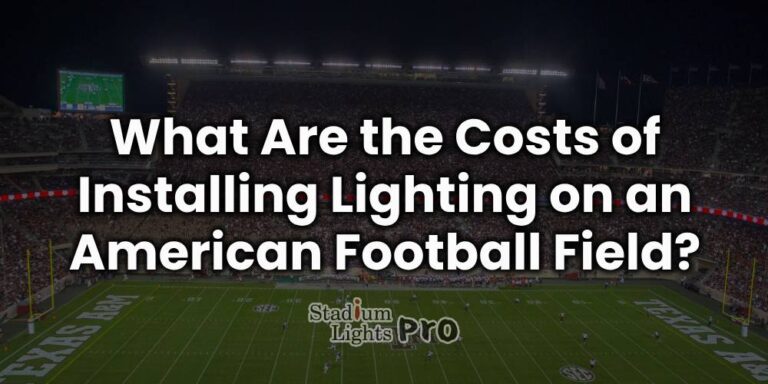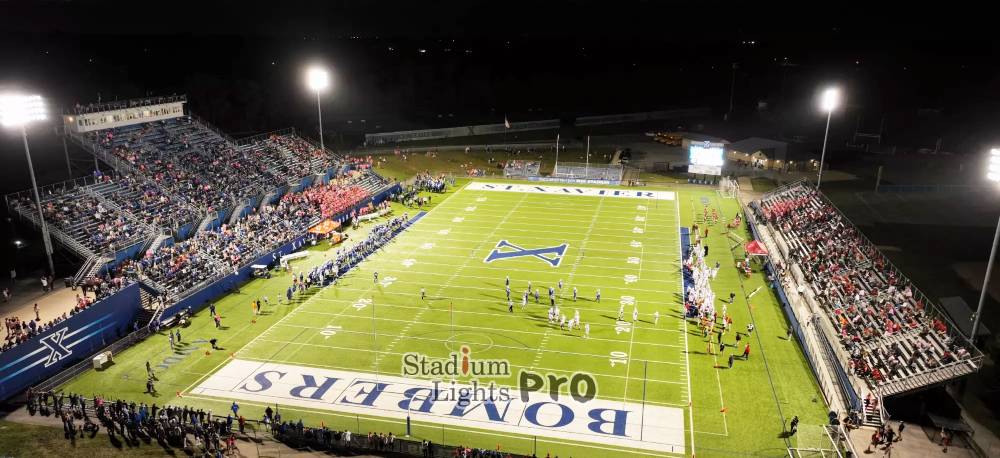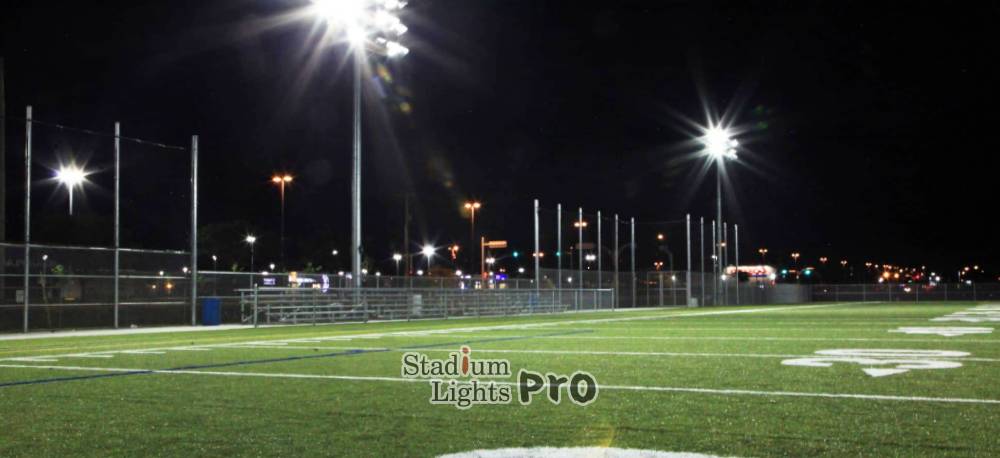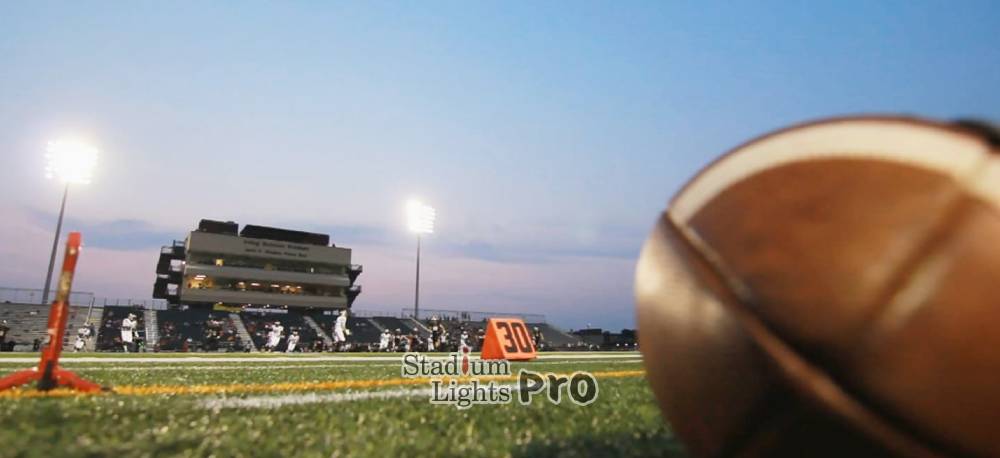
American Football Field Lighting
Lighting brings American football fields to life after sunset, allowing games to unfold under clear and vibrant visibility. It enhances the experience for players, officials, and spectators alike while supporting safety, performance, and visual clarity.

Contact us for a free lighting consultation
Table of Contents
ToggleStandards and Guidelines for Football Field Lighting

Illumination Levels for Different Levels of Play
Lighting requirements are tailored to match the competitive level and function of a football field. Recreational fields, often used for practice or community play, require basic illumination primarily aimed at safety and basic visibility. These fields operate well at lower light levels since they are not designed for large audiences or official broadcasts. High school and collegiate venues elevate these needs by requiring enhanced lighting that accommodates spectators, referees, and player performance. Fields used for official interscholastic matches or college-level competition must meet standards that support both in-person audiences and potential media recording.
Professional venues, especially those hosting national broadcasts, demand the highest lighting quality. High-definition and ultra-high-definition broadcasts require bright, even lighting with minimal shadows, high color accuracy, and no perceptible flicker. Professional stadium lighting must comply with industry guidelines established by bodies like the Illuminating Engineering Society (IES), National Federation of State High School Associations (NFHS), NCAA, and international broadcast standards. These guidelines specify the appropriate light levels, measured in foot-candles or lux, to ensure the field is visually balanced and game-ready from every angle.
Uniformity and Glare Control
Uniformity in field lighting refers to how evenly light is distributed across the entire playing area. Fields that suffer from uneven illumination can create hazardous zones where visibility drops, making it harder for players to track the ball or navigate quickly. Such inconsistencies may also create optical illusions, affect depth perception, or lead to unfair play outcomes. Designers aim for a high uniformity ratio, often calculated by comparing the minimum and average lighting levels across the surface.
Glare control plays a parallel role in the effectiveness of lighting design. Fixtures must be carefully angled and shielded to prevent direct glare into the eyes of players, referees, and fans. Poorly managed glare can hinder performance and comfort, especially for receivers tracking high passes or kickers judging trajectories. Anti-glare technologies such as visors, beam control lenses, and precision optics help reduce visual discomfort while maintaining strong field brightness.
Color Rendering and Temperature
A football field’s lighting system must allow for accurate color representation to support gameplay and media production. Jerseys, team logos, yard markers, and flags must all appear distinct and true-to-color, particularly in televised settings. The Color Rendering Index (CRI) is used to gauge how accurately a light source reveals the colors of various objects compared to natural daylight. Higher CRI scores, typically 80 and above, are preferred for sports applications.
In conjunction with CRI, the correlated color temperature (CCT) of the lighting determines its tone—ranging from warm yellow to cool blue. Football fields typically use a CCT between 5000K and 6000K to replicate daylight conditions. This balanced tone is not only more visually pleasing for athletes and audiences but also improves concentration and reduces visual fatigue during extended exposure.
Lighting for Practice vs. Game Conditions

Practice fields and competitive fields often differ in lighting setup. While game-day environments prioritize brightness, color fidelity, and dynamic lighting effects, practice fields focus more on functionality and efficiency. Teams need consistent but moderate illumination for drills and scrimmages, usually with a reduced number of fixtures and lower overall energy consumption. Motion-based controls or segmented lighting zones are often employed on practice fields to light only active areas, reducing operational costs.
During practice, players and coaches benefit from lighting that mimics game conditions without exceeding necessary brightness levels. This consistency helps acclimate players to match-like scenarios while extending the lifespan of the lighting infrastructure. Conversely, during actual games, all lighting zones are fully activated, typically at maximum output, to meet audience expectations and broadcasting requirements.
Compliance and Certification Processes
Football field lighting installations must adhere to a variety of local and national regulations. Compliance ensures the system meets safety codes, environmental impact standards, and sports-specific performance criteria. Organizations like the IES, NFHS, and NCAA provide documentation outlining lighting parameters, and meeting these standards is often a prerequisite for hosting official events.
Before a lighting system becomes operational, it may need to undergo certification from third-party inspectors or commissioning agencies. This process involves photometric testing, beam angle verification, energy use audits, and nighttime performance reviews. Some municipalities may also require environmental assessments, particularly if the field is located near residential areas or protected lands. Proper certification not only validates design quality but also aids in qualifying for grants or sponsorships tied to athletic facility improvements.

LED Lighting and Technological Advancements
Efficiency and Sustainability
The introduction of LED lighting has significantly redefined the landscape of football field illumination, offering unprecedented benefits in both energy efficiency and sustainability. Traditional lighting technologies, such as metal halide or halogen lamps, require much more electricity to produce the same level of brightness, contributing to higher operational costs and environmental strain. In contrast, LEDs use only a fraction of the energy, reducing power consumption while maintaining or even enhancing light output.
This reduction in energy consumption not only lowers utility bills but also contributes to a reduced carbon footprint. As energy demand decreases, so does the reliance on power generation, making LED systems a key component of sustainability initiatives for sports facilities. Furthermore, LEDs generate less heat than conventional lighting, leading to fewer cooling requirements in enclosed or partially enclosed stadiums. This alleviates the strain on HVAC systems, potentially lowering overall energy costs and extending the life of both lighting fixtures and stadium infrastructure.
The long lifespan of LED lights—often reaching up to 50,000 to 100,000 hours—also contributes to sustainability. Fewer replacements mean less waste, as fewer bulbs and components are discarded, which reduces the environmental impact of frequent replacements. The lifespan also makes LEDs a more sustainable option in terms of resource consumption and end-of-life disposal. These benefits position LED systems as a long-term solution that balances high performance with environmental responsibility.
Control and Smart Systems
One of the most remarkable advancements in lighting technology for sports facilities is the integration of smart systems and control mechanisms. Modern LED systems are not just static sources of light; they are dynamic, programmable, and responsive to real-time conditions. Through advanced sensors and automation, lighting can be fine-tuned for specific moments, such as dimming certain zones during downtime or brightening others during intense action sequences. For instance, a controlled lighting effect could be used during a player entrance, instantly engaging the audience with synchronized lighting and music.
Smart lighting systems allow for seamless communication between fixtures, sensors, and other devices within the stadium. Facility managers can create and pre-program lighting sequences tailored to each event, such as automatically adjusting brightness levels based on game time or crowd size. This flexibility provides full control over the ambiance, allowing lighting to evolve with the dynamics of the game and enhance the overall atmosphere. Additionally, automation reduces the need for manual adjustments during events, freeing up resources for other operational tasks.
Beyond aesthetics, smart lighting also plays a crucial role in energy management. These systems can automatically adjust lighting levels based on usage patterns, ensuring that lights are only on when necessary and at the optimal brightness. For example, during training sessions or when fewer spectators are present, the system can lower light levels, further saving on energy costs. Energy consumption data is accessible through centralized dashboards, providing insights that allow for continuous improvements in energy efficiency. Additionally, alerts can be set up to notify staff about any maintenance needs or faults, which helps address issues proactively rather than reactively.
Fixture Design and Mounting Innovations
In parallel with improvements in lighting efficiency, advancements in fixture design and mounting technologies have further elevated the functionality and ease of installation of modern lighting systems. Today’s modular lighting arrays are much lighter, more compact, and more versatile than their predecessors, making them easier to install and maintain. This lightweight design significantly reduces the structural requirements for supporting poles, lowering installation costs and enabling more creative mounting solutions.
One of the most prominent innovations is the modular design of lighting fixtures. These arrays are often composed of smaller, adjustable modules that can be configured to create the desired lighting effect for specific areas of the field. This modularity not only simplifies the installation but also allows for targeted lighting solutions. For instance, a field can be illuminated with a higher intensity near the end zones or specific player areas, while areas like the sidelines may receive less focused lighting, all with the same fixture design. This flexibility minimizes the total number of fixtures required and reduces overall capital investment, especially during retrofitting projects.
Mounting systems have also seen significant innovation, with greater emphasis placed on adaptability. Adjustable brackets, swiveling joints, and rotatable lenses allow lights to be directed precisely at areas that need illumination, reducing light spill and optimizing energy usage. Fixtures can be mounted on existing infrastructure, such as bleachers, roof structures, or even lower poles, reducing the need for entirely new support systems. This adaptability is particularly beneficial for retrofitting existing stadiums with newer lighting technologies, offering a cost-effective upgrade path without the need to replace the entire framework.
Another design breakthrough is the introduction of smart poles and fixtures equipped with sensors that can adjust the light output based on environmental conditions. These sensors detect external factors like ambient light levels or weather changes, automatically adjusting the lights to compensate. For instance, on a cloudy day or during nighttime, the lighting can automatically ramp up, ensuring optimal visibility without requiring manual input. These intelligent systems reduce the need for human intervention and ensure that the lighting system remains operational at peak efficiency.
Wireless Integration and Remote Control
Wireless integration is another key feature of modern lighting systems, enhancing control and flexibility. With wireless communication protocols, facility managers can adjust lighting settings remotely via smartphones, tablets, or desktops. This remote access allows for real-time adjustments from anywhere within the venue, or even from a remote location, making it easier to manage lighting during games or events without being tied to the stadium’s control room.
The wireless aspect also means that installation is faster and more cost-effective. There’s no need for complex wiring systems between each light fixture and the central control panel, which can lower labor and infrastructure costs during installation and reduce the potential for electrical failure or maintenance issues. Furthermore, wireless systems allow for easy scalability, enabling venues to expand their lighting setup or add additional zones as needed without major structural changes or rewiring.
Energy Monitoring and Predictive Maintenance
One of the most exciting advancements in modern lighting systems is the integration of energy monitoring and predictive maintenance tools. Through sensors and smart meters embedded in the lighting fixtures, real-time energy consumption data can be collected and analyzed. This allows facility managers to track not only the amount of energy used but also to spot inefficiencies or anomalies that might indicate the need for maintenance.
Predictive maintenance tools, powered by artificial intelligence (AI) and machine learning, go a step further by analyzing usage patterns and performance data to predict when a fixture is likely to fail or need attention. This enables proactive repairs before issues lead to system failures or game disruptions. By minimizing downtime and reducing emergency repair costs, predictive maintenance ensures that the lighting system remains fully operational and cost-effective, while extending the life of the fixtures.
Lighting Layout and Pole Placement
Design Principles and Planning
The process of lighting a football field starts long before fixtures are mounted or power is supplied. Successful lighting design stems from a detailed understanding of the field’s use, orientation, and architectural context. Planners consider the full extent of the field, including end zones, sidelines, team areas, and any surrounding infrastructure. Proper alignment with seating, scoreboards, and camera locations is vital to avoid light interference and uneven distribution.
Advanced software modeling is used to simulate how light will behave across the entire space. These tools help assess shadows, potential hot spots, and weak zones. Layouts are revised repeatedly until an optimal plan is reached that satisfies performance expectations without excess energy use. Planners must also account for obstructions such as buildings, trees, or signage that could interfere with light paths. The final blueprint incorporates fixture type, aiming angles, elevation, and coverage range to deliver smooth and consistent illumination.
Site-Specific Constraints
Each football field presents unique physical constraints that affect layout decisions. Urban locations may have limited space for pole foundations or restrictions on mounting height. In contrast, rural or open-area fields might allow taller structures but face issues like wind load and wildlife proximity. Accessibility for maintenance vehicles and electrical routing also plays a role in determining where poles can be safely and effectively installed. All of these elements are taken into account early in the planning phase to avoid costly adjustments later.
Pole Height and Orientation
Pole height directly impacts how well light is distributed across the field. Higher poles enable broader beam spread and reduce the number of fixtures required. However, structural concerns become more significant with height, requiring deep concrete footings, guy wires, or reinforced steel construction. Engineers must calculate wind loading, especially in open stadiums where tall poles act like sails during storms.
Orientation involves not just where the poles are placed but also how the fixtures are aimed. Sideline lighting typically involves four to six poles spaced evenly and aimed inward. Corner lighting fills in edge areas and end zones. Angling the fixtures correctly minimizes shadows and avoids blinding players. Some systems include articulating mounts or adjustable brackets that allow for fine-tuning after installation.
Integration with Other Infrastructure
Lighting design must complement other stadium infrastructure such as scoreboards, speaker towers, and camera cranes. These structures can obstruct beams or cause undesirable shadows if not properly accounted for. In professional environments, lighting also needs to avoid conflict with rooflines or overhead displays. Coordination with other engineers during the design process ensures that lighting is part of an integrated systems plan, not an afterthought.
Light Spill and Environmental Considerations
Managing light spill is increasingly becoming a core focus in modern field design. Spill refers to light that extends beyond the field’s intended boundaries, potentially affecting nearby homes, roadways, or ecological areas. It’s not only a matter of aesthetics and respect for neighbors but also a regulatory issue in many municipalities. Environmental impact reports often include light pollution assessments, especially near parks, rivers, or protected habitats.
Designers implement various techniques to limit spill. These include shielded fixtures, cut-off optics, and directional lenses that confine light to target zones. The use of full-cutoff luminaires, which emit no upward light, also supports dark-sky compliance initiatives. Placement of poles and aiming angles are adjusted during modeling stages to avoid directing beams toward unwanted areas.
Compliance with Light Pollution Ordinances
Many cities now enforce local ordinances aimed at controlling light pollution. These regulations may limit the total lumens emitted from a field, restrict upward light projection, or enforce curfews for illumination. Fields that don’t comply may face operational restrictions or penalties. Designers must be aware of all applicable zoning laws and environmental codes before construction begins. Compliance is not only a legal responsibility but also a mark of conscientious facility development.
Cost and Maintenance

Long-Term Cost Efficiency of Modern Lighting Systems
The financial planning behind football field lighting increasingly centers on long-term efficiency rather than initial purchase price alone. LED systems, while carrying a higher upfront cost than older technologies, deliver substantial savings over time due to their extended service life and reduced operational demands. With lifespans often exceeding 50,000 to 100,000 hours, modern LED fixtures delay the need for costly replacements and limit the frequency of labor-intensive service interventions. This durability directly reduces the total cost of ownership across a system’s lifecycle.
Budgeting for a lighting system includes more than just fixtures and installation—it encompasses ongoing maintenance, utility costs, labor, and potential emergency repairs. High-efficiency LED lights offer stable performance over many seasons, which allows organizations to project maintenance schedules and budget with greater confidence. By avoiding frequent disruptions, facilities protect revenue tied to scheduled events and broadcasting, and reduce unforeseen costs from last-minute fixes or technical failures.
Financial benefits also extend to energy use. LEDs consume far less electricity than traditional lighting technologies, leading to smaller utility bills. Over time, this reduction in energy consumption becomes a major factor in offsetting the original investment. Fields that implement smart controls, such as motion sensors and dimming systems, gain even greater savings during practice sessions, off-peak usage, or reduced-attendance events.
Durability and Its Role in Cost Containment
The ability of a lighting system to resist weather, physical damage, and operational wear significantly affects how much it costs to maintain. Modern fixtures are built using corrosion-resistant materials, tightly sealed housings, and impact-tolerant lenses, all of which reduce the likelihood of failure and extend maintenance intervals. By minimizing exposure-related degradation, these durable systems lower the frequency and urgency of on-site service, helping facilities avoid the steep costs associated with rush repairs or full fixture replacements.
The stronger the build quality of the lighting infrastructure, the less dependent a facility becomes on external contractors, equipment rentals, or large maintenance teams. Fewer interventions mean reduced labor bills and more stable operating expenses. In the long run, the up-front investment in rugged lighting systems serves as a financial safeguard against unplanned disruptions and escalating maintenance costs.
Predictable Budgeting Through Maintenance Planning
Routine maintenance becomes an asset rather than a liability when integrated into a predictable cost model. Scheduled inspections, cleaning, and software updates help extend fixture life and optimize performance. These tasks are generally low in cost and, when performed on a seasonal basis, prevent the emergence of more expensive problems. A proactive approach—such as replacing aging units in phases or performing annual lens cleaning—can be planned and budgeted easily, avoiding surprise expenses that destabilize operational planning.
Phased upgrades and consistent monitoring allow athletic facilities to allocate maintenance resources evenly across fiscal years, improving cash flow management. This measured approach stands in contrast to reactive strategies, which often involve emergency overtime labor and costly last-minute part orders.
Cost Risks of Reactive Maintenance and Downtime
Unplanned outages and emergency maintenance are among the most expensive aspects of lighting management. When a fixture fails just before or during a high-attendance game, the associated repair may require special lifts, technician surcharges, or even game postponement. The financial impact includes not only direct service costs but potential losses in ticket revenue, concessions, or media payouts. Avoiding these scenarios is one of the clearest arguments for robust design and scheduled maintenance.
By prioritizing long-life systems and regular upkeep, facilities reduce their exposure to these high-cost risks. This allows managers to maintain a controlled and consistent operating budget that doesn’t fluctuate with last-minute issues or peak season demands.
Energy Efficiency and Utility Savings
Energy consumption is one of the most persistent ongoing costs associated with field lighting. LED systems outperform older metal halide or fluorescent technologies by consuming far less electricity to produce the same or better illumination. Over the course of several years, this energy savings can equate to thousands of dollars, especially for venues with long operating hours or multiple fields in use.
Smart lighting controls further enhance this efficiency. Systems that dim automatically during warm-ups, activate only when motion is detected, or adjust to ambient light conditions can substantially reduce power usage. Facilities implementing these technologies often qualify for rebates from energy providers or public sustainability grants, adding another layer of financial return on their lighting investment.
Labor and Access Costs
Labor-related costs represent a major share of lighting maintenance budgets, especially when access to fixtures requires aerial lifts or cranes. High-mounted lights can be time-consuming and expensive to service if no ground-level lowering mechanism is available. To avoid repeated high-elevation servicing, many organizations choose pole systems equipped with lowering devices or modular designs that simplify fixture access. These systems, while initially more costly, result in meaningful labor savings over the life of the installation.
By choosing fixtures that are easier to reach or less likely to fail, facilities lower the long-term cost burden of staffing, equipment rental, and safety planning. Reduced reliance on external maintenance teams also increases control over scheduling, minimizing the disruption to practice times and event operations.
Return on Investment for LED Systems
Upgrading to LED lighting often requires a higher initial expenditure, but the long-term return justifies the investment. The savings generated from reduced energy consumption, lower maintenance frequency, and extended fixture lifespan quickly begin to outweigh upfront costs. Facilities typically observe a return on investment within five to eight years, depending on operating hours and local energy rates. This payback period can be accelerated through utility incentives or government grants aimed at promoting energy efficiency in public and recreational infrastructure.
In addition to operational savings, the value of consistent lighting performance—free from flicker, burnout, or color shift—supports professional-quality events that attract more visitors and sponsorship. This indirect financial return adds to the overall value of the investment, especially in competitive or televised environments.
Lifecycle Cost Comparison with Traditional Lighting
Comparing LEDs to older lighting technologies reveals stark differences in long-term cost. Traditional systems like metal halide often require bulb replacements every two to three years, involve more frequent ballast failures, and lose brightness over time. These recurring costs add up quickly in materials and labor. In contrast, LED systems maintain performance with minimal intervention and experience gradual, predictable output degradation, which can be managed through dimming controls or phased replacement strategies.
Over a typical 10- to 15-year period, LED systems consistently outperform legacy lighting in both reliability and cost. Factoring in energy usage, replacement cycles, and labor hours, the total lifecycle cost of LED solutions can be 30% to 60% lower than traditional systems, depending on the specific field and usage frequency.
Cost Planning for Multi-Field Complexes
For sports complexes with multiple football fields, lighting costs scale exponentially if not managed strategically. Bulk installation of high-efficiency systems can reduce per-field costs and allow for centralized maintenance operations. Shared control infrastructure, synchronized maintenance schedules, and collective purchasing agreements can reduce both capital and operational expenses.
Furthermore, when designing for multiple fields, planners can take advantage of standardized equipment across all areas, reducing inventory complexity and simplifying training for in-house maintenance teams. This uniformity helps minimize unexpected costs and ensures consistent lighting quality throughout the complex.
Broadcasting and Spectator Impact
Requirements for Television Coverage
Television broadcasts place a unique demand on sports lighting systems. Unlike in-person spectators who can adjust their eyes to different light levels, cameras depend entirely on consistent, well-calibrated illumination to capture clear footage. Games aired in high-definition, 4K, or slow-motion require lighting that maintains sharpness, contrast, and motion clarity in every frame. Even slight flickering—imperceptible to the human eye—can disrupt video feeds, particularly during slow-motion replays or dynamic camera movements.
Modern LED systems address these requirements with high refresh rates, often exceeding 4000 Hz, eliminating flicker and strobing artifacts. Camera placement is carefully mapped during the design phase of the lighting layout to ensure optimal angles and coverage. Lighting designers coordinate fixture placement and beam orientation to avoid hot spots, harsh shadows, and overexposed regions on camera. Uniform lighting not only benefits wide-angle shots but also close-ups, making it easier to follow fast-paced sequences, player expressions, and key moments in the game.
Broadcast-grade lighting must also support consistent color reproduction across various camera feeds and post-processing platforms. Fixtures are calibrated for both color rendering and temperature stability, typically within the 5000K to 6000K range, providing a clean white light that accurately reflects team colors, branding, and field markings. This visual clarity enhances the storytelling capacity of the broadcast and allows viewers to stay immersed in the action, regardless of their screen size or viewing conditions.
Enhancing the Fan Experience
In the stadium, lighting plays a central role in the energy and immersion fans feel during an event. Beyond visibility, lighting is used as an emotional tool—setting the mood, building anticipation, and celebrating momentum shifts. From dramatic spotlight introductions to synchronized light effects during player entrances or touchdowns, lighting helps convert a game into a show. These effects contribute to the overall excitement, transforming a regular season matchup into an unforgettable event.
Well-distributed lighting ensures every seat in the venue offers a clear view of the action, regardless of distance from the field. Poorly lit corners or overly bright glare zones can diminish the viewing experience and even lead to discomfort over the course of a full-length game. Thoughtful fixture orientation, anti-glare optics, and smooth light transitions help maintain comfort and engagement for the entire audience.
Facilities that integrate dynamic lighting systems into their entertainment strategy can elevate fan interaction. Systems can be synchronized with music, announcements, or digital displays to create choreographed effects. These immersive enhancements attract larger crowds and foster loyalty, especially in high school and college venues where atmosphere plays a major role in school spirit and attendance.
Revenue and Sponsorship Visibility
Broadcast and in-person lighting quality also affects revenue generation. Sponsors expect their logos, banners, and on-field activations to be clearly visible during televised games. When lighting fails to adequately illuminate sponsor areas or creates visual distortion, the value of advertising space diminishes. High-quality lighting ensures brand exposure is consistent across every angle and camera frame, making partnerships more attractive and measurable for stakeholders.
Enhanced visibility also opens doors to premium seating, exclusive events, and post-game activities that depend on safe, visually pleasing environments. This allows venues to offer elevated ticket options and attract additional sponsors who want to associate with a polished, professional event atmosphere.
Lighting and Social Media Content
In the era of smartphones and instant sharing, lighting doesn’t just affect broadcasters—it shapes what fans capture on their own. Well-lit scenes lead to higher-quality photos and videos from spectators, which are more likely to be shared online. This increases a venue’s exposure across platforms like Instagram, TikTok, and YouTube. When thousands of fans share their own angles and moments, the lighting indirectly becomes a marketing asset.
High-performance lighting encourages more organic social engagement and content creation. This not only boosts a team’s digital footprint but also adds value to the event as a social experience, especially among younger fans. It amplifies visibility far beyond the stadium walls and helps sustain interest throughout the season.
Final Thoughts
American football field lighting has progressed from rudimentary spotlights to intelligent systems that shape every aspect of the game. Through innovation, precise design, and technological adoption, modern lighting solutions now enhance visibility, comfort, and atmosphere for everyone involved. As the sport grows in scale and sophistication, lighting continues to adapt, contributing to the game’s energy, fairness, and overall appeal. Whether for local games under the Friday night sky or national championships in stadiums packed with fans, lighting plays its role with quiet efficiency, shaping how the game is seen and experienced from every angle.
